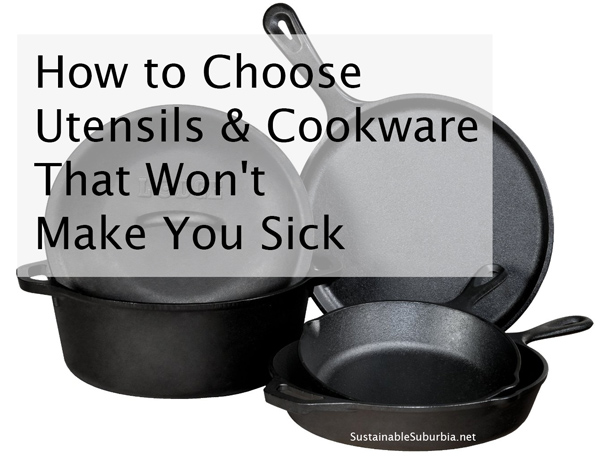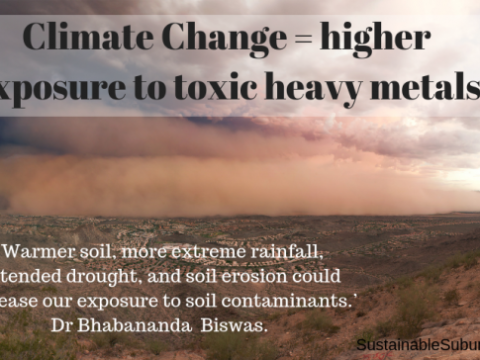
It seems like such a simple thing – toxin-free utensils. But, more and more, people are discovering that manufacturers have traded convenience for safety, and consumers are paying the price. Here’s how to choose utensils that won’t make you (or your family) sick.
Avoid Plastics, When Possible
Plastics often contain BPA, Bisphenol A, a chemical used to coat the inside of metal products like food cans, but which is also used in plastic utensils. If it leeches into your food, it can accumulate over time and cause problems with the prostate gland of developing fetuses, negatively affect the brain in adults, and cause numerous health issues in children.
If you have to use plastics, opt for BPA-free options, including BPA-free #2, #4, and #5 plastics. Be cautious of other numbered plastics which say “BPA free”, as they may have simply substituted Bisphenol S. (Kirsten’s note: there’s a chapter on the different plastics, their numbers, and what’s safe & what’s not in my book.)
Do not heat plastics in the microwave, do not store fatty, greasy, or acidic foods in plastic containers, and do not use scratched or badly-worn or cloudy plastics for food storage. Hand-wash all plastic utensils, tupperware, or anything else used for food storage or in the cooking process.
Use High-Quality Cutlery
Good quality cutlery is usually designed in such a way that it has no grooves where grit and germs can accumulate between washes. Particularly pay attention to the connection between the knife handles and the blades. The smoother and seamless the connection, the less likely any bacteria will accumulate between washes. Even forks can accumulate grit in between each of the fork pins. Higher end cutlery, or well designed cheaper versions usually avoid such issues.
The best knives will not be stainless steel (oddly enough), so they will require hand washing and drying.
Avoid Non-Stick Surfaces
Non-stick surfaces used to be popular at one time. To some extent, they still are. But, they harbor a dirty secret. Teflon, and other chemical non-stick coatings, are manufactured using perfluorooctanoic acid (PFOA) and contain Polytetrafluoroethylene (PTFE), both of which, according to the American Cancer Society, are considered likely human carcinogens.
When it is heated, cookware treated with non-stick surfaces can emit fumes that that have been shown to be harmful to birds and can potentially make you seriously ill. Overheating of non-stick pans, or scratching them with metal utensils, can cause the chemicals to be released. If you eat them, you’re ingesting something that could make you sick either immediately or in the long-term.
Don’t Use Aluminum Cookware
Aluminum is a soft metal that, when heated, can leech itself into your food and water. Aluminum has been linked to brain disorders as well as behavioral abnormalities and is considered a toxic substance by the Agency for Toxic Substances & Disease Registry.
If you have aluminum cookware, get rid of it. Some manufacturers have gotten wise to aluminum’s toxicity, and have opted to sell anodized aluminum cookware. This is slightly safer, but not by much. The anodization can break down over time, and then you’re back where you started.
 Use Glass, 304 Grade Stainless Steel,
Use Glass, 304 Grade Stainless Steel,
Or Cast Iron
Food-grade 304 stainless steel is one of the safest cooking metals around. Stainless steel is an alloy, meaning it’s a mix of different metals – namely iron with 10.5 percent chromium. Sometimes, nickel is also used. The grading refers to its quality, durability, and temperature resistance.
Often, numbers like “18/8” or “18/10” are used to show the composition of the stainless steel and the amount of chromium and nickel in the product.
The first number refers to the amount of chromium in the alloy (by percentage), while the second number denotes the nickel content (again, by percentage).
Finally, because stainless steel is not the best conductor of heat, aluminum is often “sandwiched” between two layers of the alloy. The aluminum does not ever react with, or come into contact with, food.
Low quality stainless steel will either have no, or negligible, amounts of nickel added to it. Some manufacturers substitute manganese for the nickel to make it more affordable. Although safe, these cheaper grades are not as corrosion resistant as the 300 series (e.g. 304 grade) steel.
(Kirsten’s note: See also my previous article which covers why some people prefer to avoid true stainless steel)
Use Cast Iron
Finally, there’s good-old cast iron. Cast iron has been used for centuries. Unfortunately, the art of cooking with this metal remains largely undiscovered.
The secret to cooking with cast iron is the seasoning. A properly seasoned cast iron pan will beat teflon any day. But, you need an edible drying oil to properly season a pan. Sheryl’s Blog explains how to properly season cast iron. [Note from Kirsten: If you think you already know how to do this – read her post anyway!]
Once you’ve got it, cast iron will remain one of the best cooking options you’ll ever own.
Erin Perryman loves to cook healthy foods for her large family. When she’s not cooking, she’s researching her next recipe and writing about it. You can find her engaging and helpful posts on various websites and blogs. Visit BedBathandBeyond for all your kitchen essentials, including knives.
_______
Top photo from Amazon.com – this is the set of cookware we took camping with us in the States last year and we were very happy with them. We gave away the dutch oven before we came back (too heavy for our luggage!), but we kept the pans and use them all the time!



We use the same non stick pans since our wedding which was 10 years ago. These days I cook in the slow cooker and use my Tupperware containers to microwave. I’ve never thought to cook in cast iron.
I love cast iron now Bec. And as an added bonus I tend towards iron deficiency, so a little extra iron in my food is a good thing
I do want a slow cooker though…
I need to invest in a new fry pan. Ours are teflon which bugs me, but it’s what we have.
I should upgrade though.
Definitely Jess!
I am in love with my cast iron now. I did have scanpan, which isn’t teflon but do still have the nasty chemicals I believe (albeit in a different – supposedly less dangerous – form). But I love my cast iron much better!
Really great post. Very interesting. We’ve always used BPA free products, but even they are not safe when heating. I used to heat my daughter’s bpa free bottles in the microwave. She started to develop a growth under one of her breasts and after consulting the paed he suggested that it could be due to heating the bottles. We stopped doing that and it returned to normal. Very scary.
Wow that really is scary Renee! And you’re so right – we just don’t really know enough about plastics yet I think, to declare any of them safe. That’s why I like that Erin says just avoid where possible.
I like the saying “5, 4, & 2 we think are safe for you (at the moment)” They are the best plastic choices based on current research, but I’m with you, I just stick with not heating in plastic at all, generally.
We got some great cast iron pots as a wedding gift. I love cooking with them, harder to lift though!!
So true Michelle! My husband keeps putting ours in the bottom shelf of our cupboard. I need to get him in the habit of putting them higher up, and the one we use most on top, ’cause they are sooo heavy!